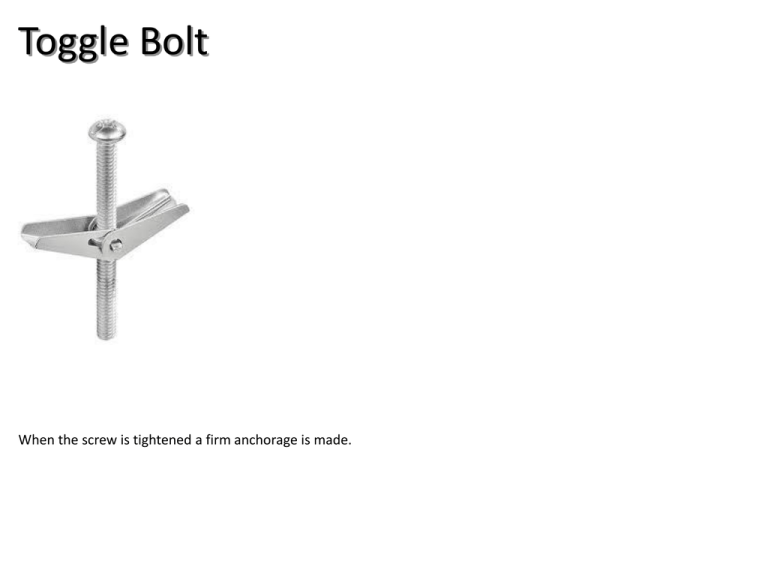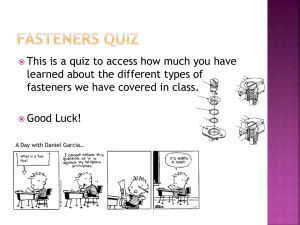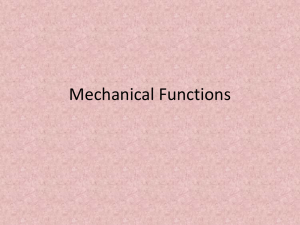Fasteners
advertisement

Toggle Bolt When the screw is tightened a firm anchorage is made. Machine Screw The head is slotted for a screwdriver and may be either round of flat. Typical sizes 4-12. Plow Bolt No wrench is necessary to hold the bolt head. Machine Bolt The head and nut may be square or hexagon shaped. Lag Bolt The bolt has a square or hex head with a tapered wood screw on the other end. Common sizes 1/4 to 1/2 in diameter, 2" to 12" long. Also called a Lag Screw. Carriage Bolt Never use a washer under the head. Use to bolt wood. Cap Screw It resembles a short bolt with a hexagon head with either coarse, fine, or metric thread. Term describes machine bolts and machine screws. Eye Bolt It has an eye on one end and coarse or fine threads on the other. Grade 2 Bolt Soft bolt commonly used for landscape applications and other applications where strength is not important. Grade 5 Bolt Mildly hardened bolt used commonly in machinery and equipment applications. Three markings on the head. Grade 8 Bolt Hardened bolt used where high tensile strength is required. 6 markings on the head. Hex Nut It may have NC, NF, or metric threads. Wing Nut Used where hand tightening (no wrench) is desired such as inspection covers. Square Nut Used on farm implements with carriage bolts, machine bolts, stoves bolts and plow bolts. Self-Locking Nut When tightened on a bolt the scored threads bite into the threads of the bolt preventing it from backing off. Castellated Hex Nut Used with a cotter pin to prevent loosening or tightening. Top of the nut is smaller in diameter than the base. Cap Nut A nut closed on one side to cover an exposed bolt. Slotted Hex Nut It differs from the castellated nut in that there is no stepped-in castle-like top. Finishing Washer This is a chrome plated countersunk washer used with oval head wood or metal screws. Malleable Iron Washer Used where excess pressure or stress is exerted on wooden structures. Flat Washer Used to prevent the nut from rubbing and becoming imbedded in the bolted material. Also called a Cut Washer. Fender Washers The large holes are used for aligning or adjusting for proper fit. Lock Washer It should not be used on wood. Set Screw When screwed into a set collar the cup point makes an indentation in the shaft preventing the collar from vibrating loose. Sheet Metal Screws Head types are flat, round, pan, oval and binding. Screw Eye It may be described as a screw with an eye or ring head. Torx Head Screws The head is similar to the Phillips but having a six point star shaped opening in the center of the head rather than a four point star. Self Tapping Screws Screw has a sharp point with coarse threads that make their own threads when screwed into a pre-drilled hole that is smaller than the diameter of the screw. Self Drilling Screws No pre-drilling is necessary when using a self drilling screw. Drywall Screws All Are Phillips Except the Hex Wafer Head. Used to fasten drywall. Bugle shaped flat head. Screw Hook Can be screw into wood walls or concrete or masonry when pre-drilled and a plastic or lead anchor is used. Deck Screws A straight shank wood screw with a bugle head. Commonly made with a Phillips or square drive 2 1/2" of longer. Coated to prevent rusting. Wood Screws A tapered screw with a round, oval, or flat head. The threaded portion of the screw is tapered with a very coarse thread and cuts its own thread as it is turned into the wood. Shown L-R oval head, round head, flat head Phillips, and flat head slotted. Duplex-Head Nail The point is sharp, and there are two heads, one above the other, to make removal easy. Common sizes 6d, 8d, 16d. Box Nail Roughly speaking, d equals 1/4 inch in length, but this is not constant. The shank is smaller in diameter than the common nail to prevent splitting of the wood. Common sizes 2d to 16d Common Nail Roughly speaking, d equals 1/4 inch in length, but this is not constant. The shank is larger in diameter than the box nail making the nail less likely to bend. Common sizes 2d – 20d. Sizes larger then 20d are often called spikes. Finish Nail The sizes range from 2d to 20d. The nail is designed to be counter sunk and the hole filled. Galvanized Nail Common, box, and finish nails are available for exterior use with a galvanized coating. The coating may be hot dipped (thicker) or electro-plated (EG). Spiral Shank Nails Designed for the construction and repair of wood pallets. These spiral shank nails are also good for re-nailing wagon beds, trailers. Wire Brad The size is expressed in wire gauge and ranges from 1/4 to 1 1/2 inches long. Cement Coated Nails Sizes range from 2d to 16d. Commonly found in a green coating in 8d and 16d ("sinkers"). Blue Plaster Board Nail The range in size is 1 to 1 1/2 inches. Aluminum Roofing Nails Sizes range from 1 to 1 1/2 inches long. Used to apply aluminum roofing. Lead-Head Nails Lead washer is to prevent oxidation between the head of the nail and the galvanized roofing and also prevents leakage. Galvanized Shingle Nail The 3d is generally used for shingling. Galvanized Roofing Nail The head is about 1/2 inch in diameter, and the length ranges from ¾ to 2 inches. Furring Nail This allows the wire to become a reinforcing agent and the nails hold the plaster to the wall. Corrugated Fastener The size is 1/4 to 1 inch in depth and 2 to 7 corrugations. Used to fasten wood. Cotter Pin This prevents the nut from working loose. Also called a Cotter Key. Soft Iron Rivet The size is based on length and diameter. Pop Rivet A pop rivet tool is required to set the rivet. Pop Rivet Tool Tool is adjustable to use the various sizes (diameter) of rivets available. Rivet Set A rivet set is a small bar of steel with a hole drilled in the end to receive the rivet, and with a cup-like depression for forming a round head on the rivet.






